Abstract
This study was designed to look in detail at the paths to diagnosis for a group of 197 children with congenital sensorineural hearing impairment (SNHI), who were diagnosed between 1989 and 1991 in the state of Victoria, Australia. Despite the existence of universal infant screening at 7-9 months by distraction test or questionnaire, the median age at diagnosis for the study group was 18.0 months, with median age at aid fitting of 20.8 months, and median age at commencement of specialised intervention programmes of 22.3 months. Parent questionnaires completed for 143 (73%) of these children showed that 49% had known risk factors for hearing loss yet only 20% of them had been referred for audiological assessment before the 7-9 month screen. Only 63% of those eligible for the 7-9 month screen had received it. Of those children who were screened by distraction test 46% passed as did 57% of those screened by questionnaire. Twenty four parents (17%) described how they had initially 'denied' their own observations of their infants' abnormal hearing behaviour. When concerns were raised with professionals, 10% of parents were falsely reassured without audiological assessment. Detection methods are failing through a combination of poor screen test efficacy, incomplete population coverage, and parental and professional denial.
Full text
PDF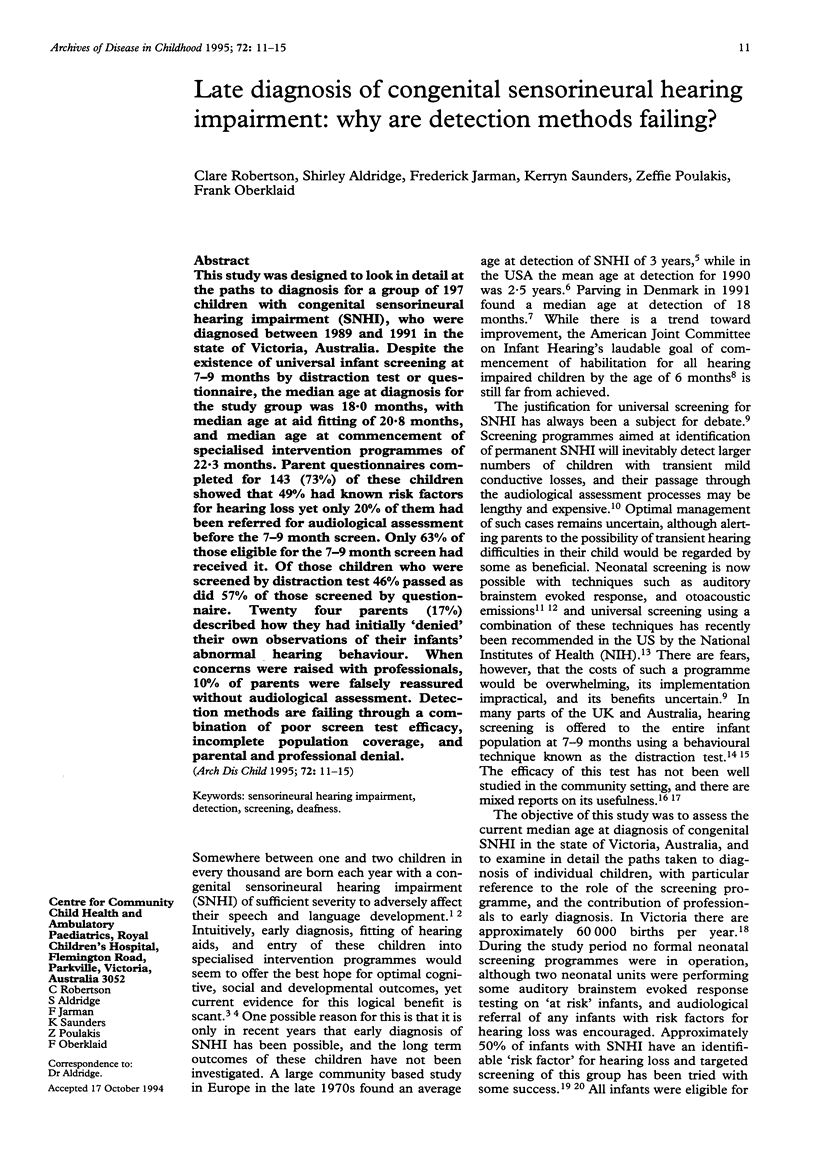
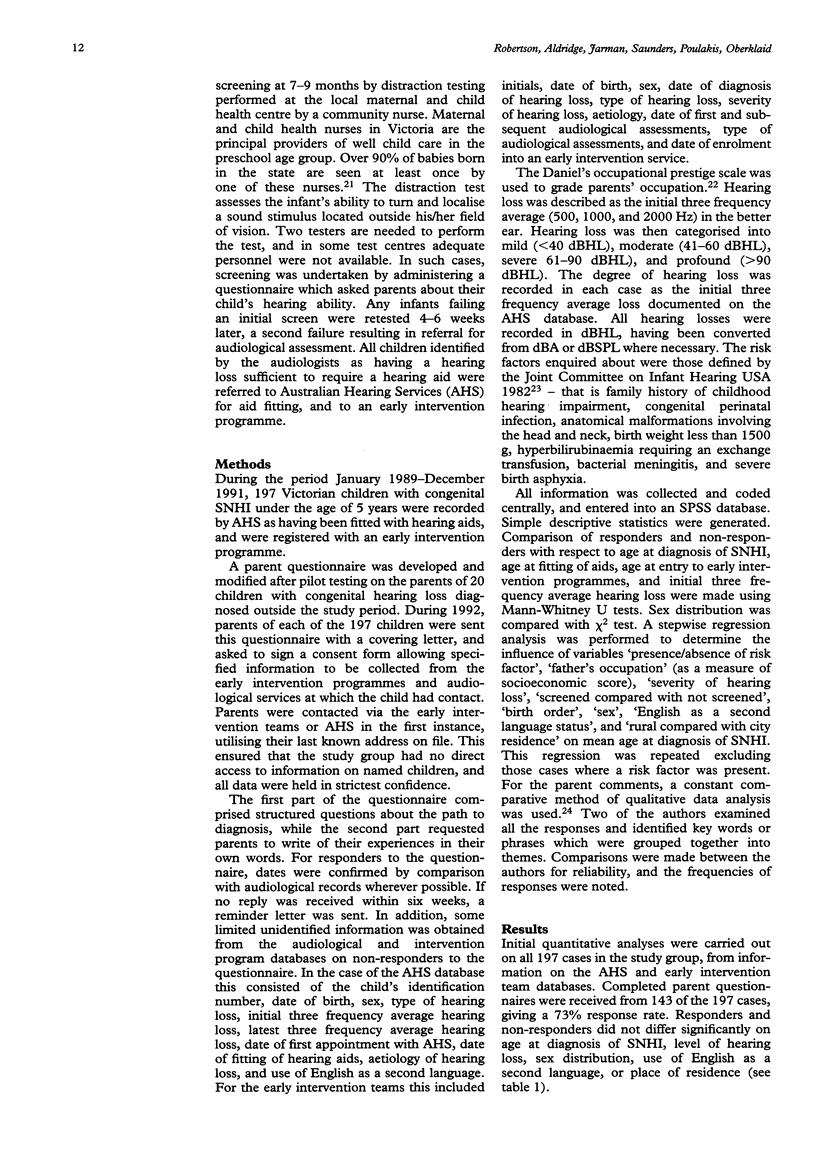
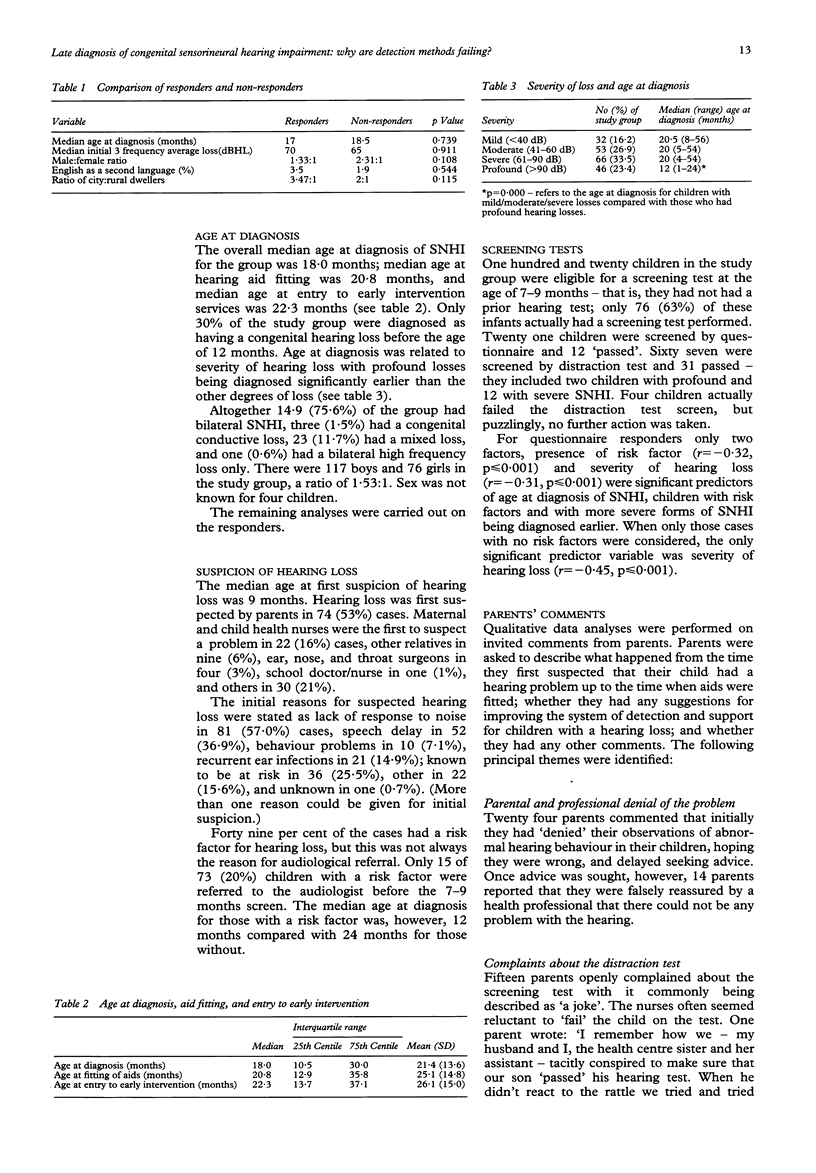
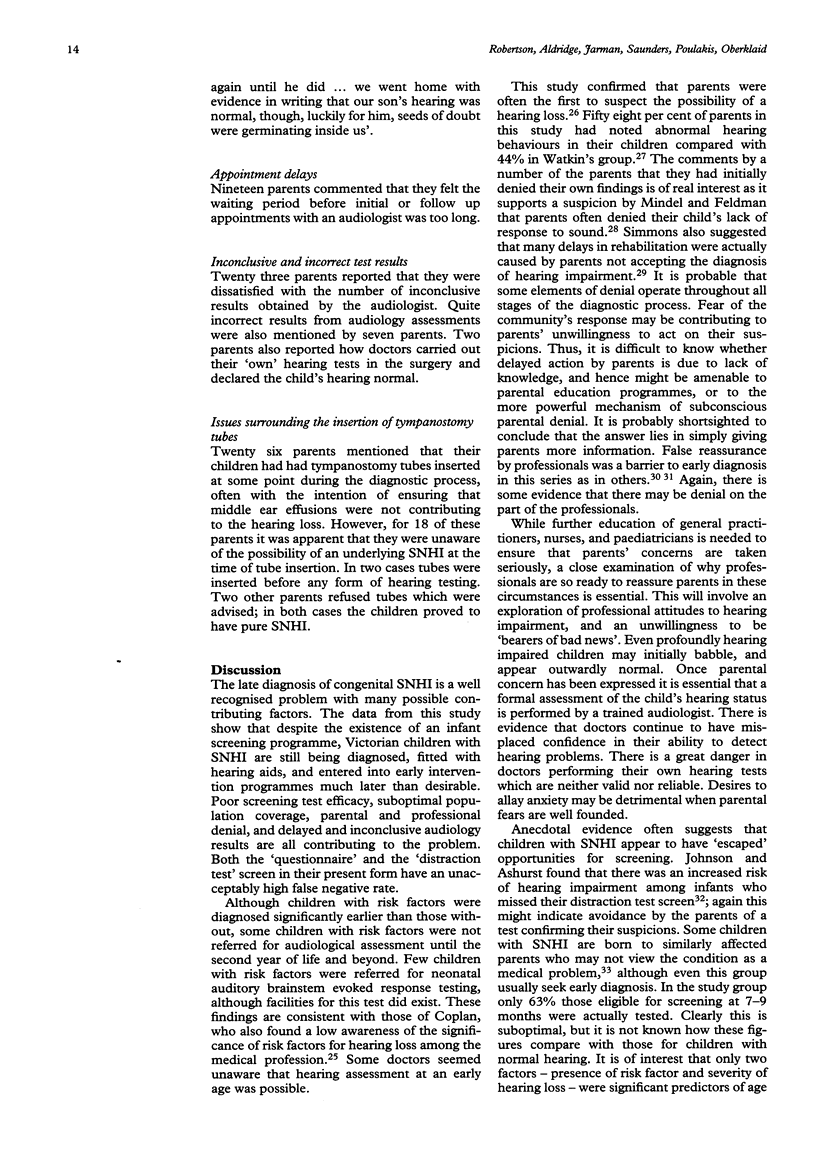
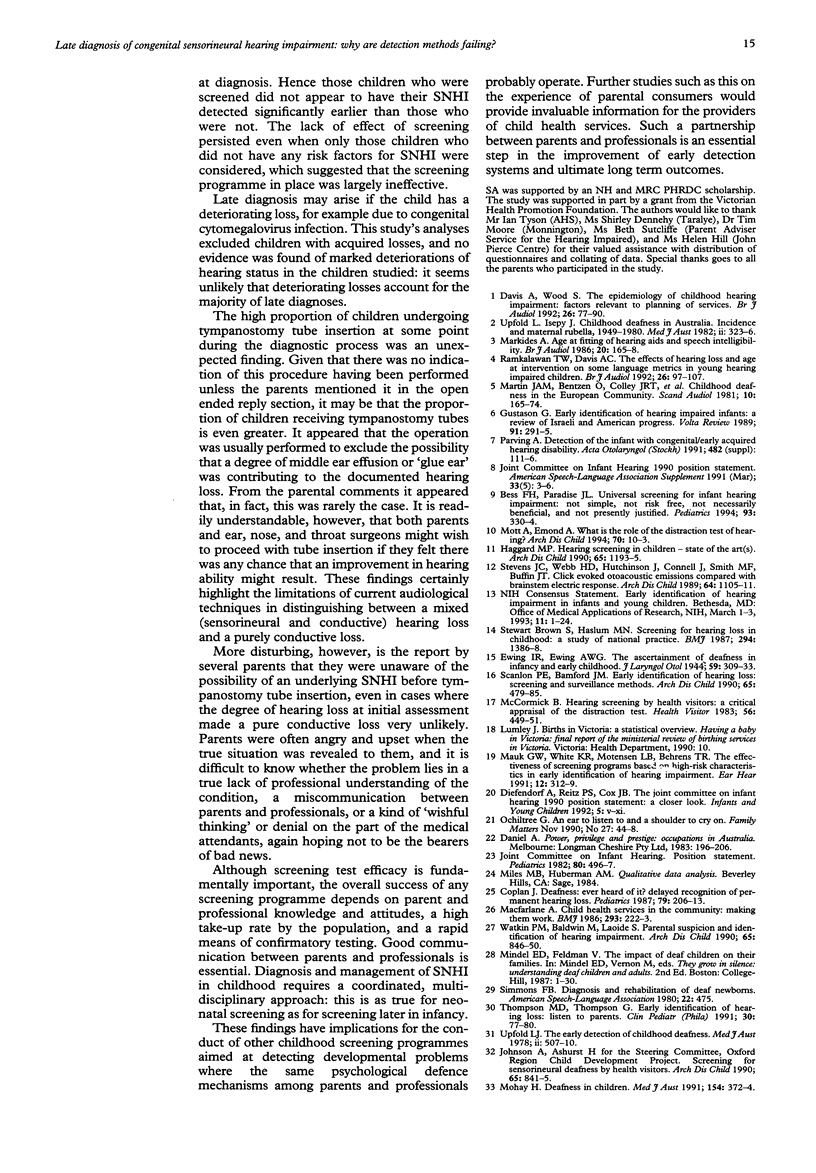
Selected References
These references are in PubMed. This may not be the complete list of references from this article.
- Bess F. H., Paradise J. L. Universal screening for infant hearing impairment: not simple, not risk-free, not necessarily beneficial, and not presently justified. Pediatrics. 1994 Feb;93(2):330–334. [PubMed] [Google Scholar]
- Coplan J. Deafness: ever heard of it? Delayed recognition of permanent hearing loss. Pediatrics. 1987 Feb;79(2):206–213. [PubMed] [Google Scholar]
- Davis A., Wood S. The epidemiology of childhood hearing impairment: factor relevant to planning of services. Br J Audiol. 1992 Apr;26(2):77–90. doi: 10.3109/03005369209077875. [DOI] [PubMed] [Google Scholar]
- Haggard M. P. Hearing screening in children--state of the art(s) Arch Dis Child. 1990 Nov;65(11):1193–1195. doi: 10.1136/adc.65.11.1193. [DOI] [PMC free article] [PubMed] [Google Scholar]
- Johnson A., Ashurst H. Screening for sensorineural deafness by health visitors. The Steering Committee, Oxford Region Child Development Project. Arch Dis Child. 1990 Aug;65(8):841–845. doi: 10.1136/adc.65.8.841. [DOI] [PMC free article] [PubMed] [Google Scholar]
- Macfarlane A. Child health services in the community: making them work. Br Med J (Clin Res Ed) 1986 Jul 26;293(6541):222–223. doi: 10.1136/bmj.293.6541.222. [DOI] [PMC free article] [PubMed] [Google Scholar]
- Markides A. Age at fitting of hearing aids and speech intelligibility. Br J Audiol. 1986 May;20(2):165–167. doi: 10.3109/03005368609079011. [DOI] [PubMed] [Google Scholar]
- Martin J. A., Bentzen O., Colley J. R., Hennebert D., Holm C., Iurato S., de Jonge G. A., McCullen O., Meyer M. L., Moore W. J. Childhood deafness in the European community. Scand Audiol. 1981;10(3):165–174. doi: 10.3109/01050398109076177. [DOI] [PubMed] [Google Scholar]
- Mauk G. W., White K. R., Mortensen L. B., Behrens T. R. The effectiveness of screening programs based on high-risk characteristics in early identification of hearing impairment. Ear Hear. 1991 Oct;12(5):312–319. doi: 10.1097/00003446-199110000-00003. [DOI] [PubMed] [Google Scholar]
- McCormick B. Hearing screening by health visitors: a critical appraisal of the distraction test. Health Visit. 1983 Dec;56(12):449–451. [PubMed] [Google Scholar]
- Mohay H. Deafness in children. Med J Aust. 1991 Mar 18;154(6):372–374. doi: 10.5694/j.1326-5377.1991.tb121123.x. [DOI] [PubMed] [Google Scholar]
- Mott A., Emond A. What is the role of the distraction test of hearing? Arch Dis Child. 1994 Jan;70(1):10–13. doi: 10.1136/adc.70.1.10. [DOI] [PMC free article] [PubMed] [Google Scholar]
- Parving A. Detection of the infant with congenital/early acquired hearing disability. Acta Otolaryngol Suppl. 1991;482:111–117. doi: 10.3109/00016489109128033. [DOI] [PubMed] [Google Scholar]
- Ramkalawan T. W., Davis A. C. The effects of hearing loss and age of intervention on some language metrics in young hearing-impaired children. Br J Audiol. 1992 Apr;26(2):97–107. doi: 10.3109/03005369209077877. [DOI] [PubMed] [Google Scholar]
- Scanlon P. E., Bamford J. M. Early identification of hearing loss: screening and surveillance methods. Arch Dis Child. 1990 May;65(5):479–485. doi: 10.1136/adc.65.5.479. [DOI] [PMC free article] [PubMed] [Google Scholar]
- Simmons F. B. Diagnosis and rehabilitation of deaf newborns: part II. ASHA. 1980 Jul;22(7):475–479. [PubMed] [Google Scholar]
- Stevens J. C., Webb H. D., Hutchinson J., Connell J., Smith M. F., Buffin J. T. Click evoked otoacoustic emissions compared with brain stem electric response. Arch Dis Child. 1989 Aug;64(8):1105–1111. doi: 10.1136/adc.64.8.1105. [DOI] [PMC free article] [PubMed] [Google Scholar]
- Stewart-Brown S., Haslum M. N. Screening for hearing loss in childhood: a study of national practice. Br Med J (Clin Res Ed) 1987 May 30;294(6584):1386–1388. doi: 10.1136/bmj.294.6584.1386. [DOI] [PMC free article] [PubMed] [Google Scholar]
- Thompson M. D., Thompson G. Early identification of hearing loss: listen to parents. Clin Pediatr (Phila) 1991 Feb;30(2):77–80. doi: 10.1177/000992289103000202. [DOI] [PubMed] [Google Scholar]
- Upfold L. J., Isepy J. Childhood deafness in Australia. Incidence and maternal rubella, 1949-1980. Med J Aust. 1982 Oct 2;2(7):323–326. [PubMed] [Google Scholar]
- Upfold L. J. The early detection of childhood deafness. Med J Aust. 1978 Nov 18;2(11):507–510. doi: 10.5694/j.1326-5377.1978.tb131680.x. [DOI] [PubMed] [Google Scholar]
- Watkin P. M., Baldwin M., Laoide S. Parental suspicion and identification of hearing impairment. Arch Dis Child. 1990 Aug;65(8):846–850. doi: 10.1136/adc.65.8.846. [DOI] [PMC free article] [PubMed] [Google Scholar]


